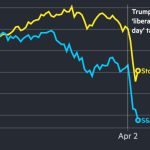The U.S. launch of
Bitcoin
exchange-traded funds was a landmark moment for digital assets, but an analyst warns that by becoming more accessible, Bitcoin might also become less attractive.
The Securities and Exchange Commission earlier this month approved the first ETFs that will hold Bitcoin itself; anticipation of these funds since last summer helped push cryptos out of a bear market. So far, however, approval has ushered in a bit of a “sell the news” dynamic.
Bulls still hope the funds will bring a fresh wave of retail and institutional investors to digital assets in general and lift prices. But that might not be the end result, according to Matt Bauer, a strategist at Ned Davis Research.
Direct ownership and low fees linked to these funds are likely to drive adoption of Bitcoin ETFs, Bauer wrote in a note this week, but it’s too early to determine if this improved accessibility will boost demand for Bitcoin itself. More importantly, greater access to the world’s largest cryptocurrency is actually eroding what made it stand out from other assets in the first place, he says.
“Increased accessibility has led to declining volatility, a declining Sharpe ratio, and a rising correlation to the S&P 500” for Bitcoin, Bauer writes.
Here’s why those are bad things for Bitcoin investors.
Bitcoin’s volatility has still steadily declined since its launch more than a decade ago. Volatility—as measured by the 100-day average of daily price swings in percentage points—hasn’t exceeded 4.5% since the introduction of Bitcoin futures, which track the price of the spot token, according to Bauer. Since the 2021 launch of the
ProShares Bitcoin Strategy ETF
—a Bitcoin futures fund—that metric hasn’t exceeded 3.5%. Over the past year, volatility has stayed below 2.6%.
“As adoption and product offerings spread, it appears volatility may continue to be suppressed,” said Bauer. “This is not great news for Bitcoin bulls as the cryptocurrency has tended to perform better during periods of rising volatility.”
It should be noted, though, that Bitcoin is still quite volatile compared with the broader stock market. The Cboe Volatility Index, or VIX—known as Wall Street’s “fear gauge” for the
S&P 500
—currently stands at 13. Bitcoin’s volatility measure of 2.6% approximates a VIX reading of 33. But Bitcoin may not stay this way.
Next is the Sharpe ratio, an important metric of risk-adjusted return developed by Nobel Prize winner William Sharpe. In general, a higher Sharpe ratio means higher risk-adjusted returns: A ratio of less than 1 isn’t good, with a ratio of 1-2 being good, and 2 to 3 being very good.
In Bitcoin’s early days, the digital asset had extended periods when its trailing Sharpe ratio was above 2, but the ratio has been roughly in line with that of the S&P 500 for the past five years, according to Bauer. For all of last year, Bitcoin’s Sharpe ratio actually lagged behind that of the benchmark stock index.
One more thing: Bitcoin is, by and large, becoming more like the S&P 500. And why would investors want to jump into the digital asset, if they can get similar results from the good old-fashioned stock index?
“Prior to the pandemic, Bitcoin exhibited a mildly negative correlation to the S&P 500, often functioning as a ‘safe haven’ asset during periods of risk-off,” said Bauer. “However, since the pandemic, that correlation has trended higher as barriers to access lowered and adoption increased.”
The conclusion from Bauer’s analysis is straightforward: Bitcoin is behaving more like the S&P 500, while still being about twice as volatile—and getting less volatile, which isn’t necessarily a positive for the crypto—and lagging behind the index in terms of risk-adjusted returns.
Add that to the Bitcoin bear case.
Write to Jack Denton at jack.denton@barrons.com
Read the full article here













